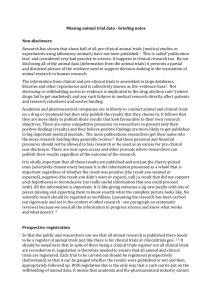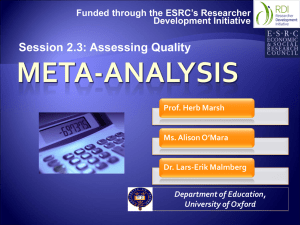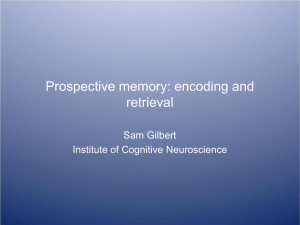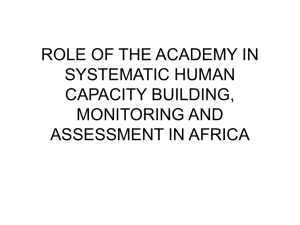Discussion opener Iain Chalmers
advertisement
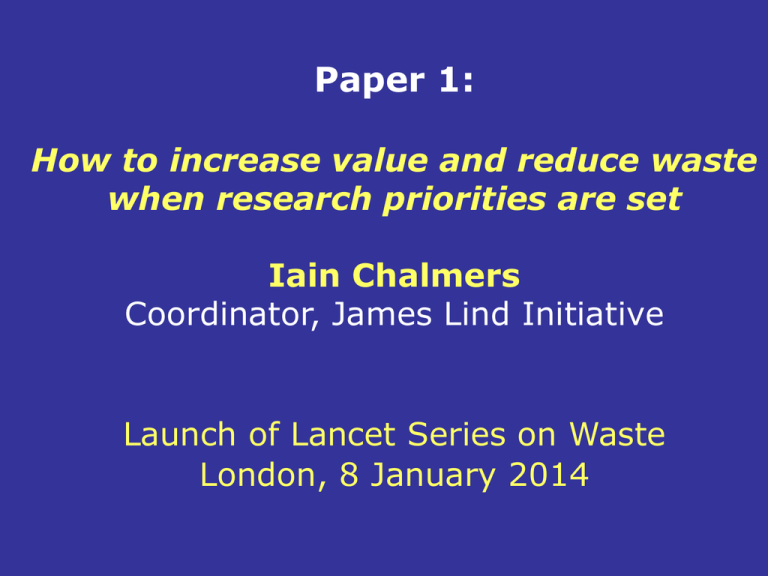
Paper 1: How to increase value and reduce waste when research priorities are set Iain Chalmers Coordinator, James Lind Initiative Launch of Lancet Series on Waste London, 8 January 2014 Iain Chalmers, health services researcher Michael B Bracken, epidemiologist Benjamin Djulbegovic, oncologist, methodologist Silvio Garattini, clinical pharmacologist Jonathan Grant, science policy analyst Metin Gulmezoglu, clinical trialist David Howells, preclinical animal researcher John PA Ioannidis, methodologist, bibliometrician Sandy Oliver, social scientist Issue 1 Relevant for advancing knowledge High Pure basic research Use-inspired basic research CURIE QUADRANT PASTEUR QUADRANT without considering relevance to practical problems “The scandal of poor medical research”. Low (Altman D. BMJ 1994;308:283-4) WASTE QUADRANT Low After Stokes 1997 to address important practical problems Pure applied research to address important practical problems DOLL QUADRANT High Relevant for immediate application Health dividends from basic research • Comroe & Dripps claimed 62 per cent of all articles judged essential for later clinical advances resulted from basic research. • The rigour and objectivity of the C&D analysis was challenged (eg by Richard Smith 1987). • Attempted replication of the C&D analysis found that it was ‘not repeatable, reliable or valid’, and that only between 2 and 21 per cent of research underpinning clinical advances could be described as basic (Jonathan Grant et al. 2003). Recent bibliometric analyses (1) Recent bibliometric analyses (2) UK concern about inadequate capacity for testing findings from basic research in applied research From Chalmers I, Rounding C, Lock K. Descriptive survey of non-commercial randomised trials in the United Kingdom, 19802002. BMJ 2003;327:10171019. Public/charitable funding of medical research, by investment category, 2004/5 and 2009/10 (UK Clinical Research Collaboration, 2012). Type of research 2004/5 2009/10 Pure basic (aetiology and 68.3 59.4 Pure applied (prevention, 21.2 27.2 Use-led basic 10.7 13.3 (categories included) underpinning) detection & diagnosis, treatment evaluation, disease management, health services) (development of detection, diagnosis and treatment) Recommendation 1 Issue 2 Recommendation 2 Low priority questions addressed in research on treatments for osteoarthritis of the knee Tallon, Chard and Dieppe. Lancet, 2000. 100% 20 89 90% 307 Education and training, service delivery, psychological, physical, exercise, complementary, diet, other 80% 70% 74 60% 332 50% 689 40% 30% 29 20% 10% Radiotherapy, surgery and perioperative, devices, and diagnostic Drugs, vaccines and biologicals 397 23 0% JLA patient-clinician Priority Setting Partnerships Registered noncommercial trials Registered commercial trials Interventions mentioned in research priorities identified by James Lind Alliance patient-clinician Priority Setting Partnerships, and among registered trials, 2003-2012. (Chalmers et al. 2013) Waste resulting from ignoring outcomes of importance to patients Priority treatment outcome from a survey of patients with rheumatoid arthritis was not pain It was fatigue Issue 3 Recommendation 3 Recommendation 4 STUDIES IN ANIMALS 20 animal studies: “The results of this review did not show convincing evidence to substantiate the decision to perform trials with nimodipine in large numbers of patients. Stroke 2001;32:2433-8. STUDIES IN HUMANS Horn J, Limburg M. Calcium antagonists for acute ischemic stroke. The Cochrane Database of Systematic Reviews, 2000 “46 trials were identified of which 28 were included (7521 patients). No effect of calcium antagonists on poor outcome at the end of followup (OR 1.07, 95% CI 0.97/1.18), or on death at end of follow-up (OR 1.10, 95% CI 0.98/1.24) was found.” 2005 “systematic reviews and meta-analyses [are needed] to evaluate more fully the predictability and transferability of animal models.” Increase in proportion of meta-analyses in PubMed, 1999-2011 Human Animal Bracken 2012 Some illustrative examples of waste from redundant research Redundant animal research Sena et al. 2010 Redundant clinical research… …leaving key questions unaddressed Redundant epidemiological research Cumulative odds ratios for front versus non-front sleeping position of sudden infant deaths versus controls. Gilbert et al. 2005. Consequences of failure to analyse epidemiological research cumulatively “Systematic review of preventable risk factors for SIDS from 1970 would have led to earlier recognition of the risks of sleeping on the front and might have prevented over 10 000 infant deaths in the UK and at least 50 000 in Europe the USA and Australasia.” What are research regulators, research funders and academia in the UK doing to reduce this sometimes lethal waste? Research ethics committees/IRBs Inappropriate continued use of placebo controls in clinical trials assessing the effects on death of antibiotic prophylaxis for colorectal surgery Department of Health 2001 ”It is essential that existing sources of evidence, especially systematic reviews, are considered carefully prior to undertaking research… Research which duplicates other work unnecessarily, or which is not of sufficient quality to contribute something useful to existing knowledge, is in itself unethical.“ MS Society supports systematic reviews The Wellcome Trust 2003 2013 Science is cumulative, and scientists should cumulate scientifically. Scientific cumulation entails using (i) methods to reduce systematic errors (biases) and where appropriate and possible, (ii) meta-analysis to reduce random errors (the play of chance). Patients have suffered and died unnecessarily and resources for research have been wasted because the research community has failed to review existing evidence systematically when planning new research. Why should patients and the public trust us if we and our professional institutions fail to make systematic, efficient use of the results of the research that the public has funded? Alessandro Liberati





